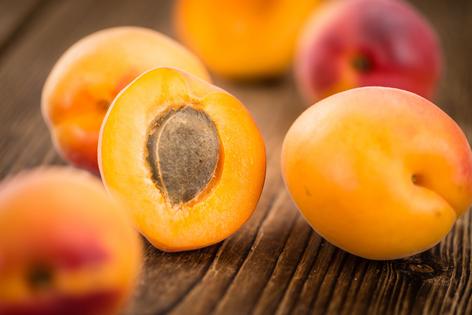Environmental Nutrition: Apricots are so apropos
The golden-orange apricot is among the first fruits to announce summer has arrived.
The folklore
Farmers' market stands are aglow with these petite, plump orbs, soft and gently sweet. This seasonal favorite originated in China about 4,000 years ago, but apricots are famously associated with Armenia (the scientific name is Prunus armeniaca). Spanish explorers brought them to the missions in California, where they are prolific today. Full of vitamins and antioxidants, apricots are a nutritious gem with delicious culinary versatility.
The facts
Apricots are members of the rose family, along with peaches, plums, cherries and almonds. Because they ripen earlier than most seasonal fruits, the Romans named the trees praecocia (meaning precocious, or early), which became the name apricot. There are many apricot varieties that range in size and color, from pale yellow to deep orange and even light red, including Rival, Harglow, and Sun-Glow. Apricots are plump with eye-protective vitamin A -- a one-cup serving dishes 64 percent DV (Daily Value, based on 2,000 calories/day), and 27 percent DV of antioxidant vitamin C, plus a host of other antioxidant compounds, including carotenoids and catechins.
The findings
Apricots are a rich source of nutrients and powerful plant compounds, including polyphenols, carotenoids and vitamins, which play important roles in preventing disease and protecting health (Annals Food Science and Technology, 2015). Evidence shows that age-related eye diseases may be prevented by dietary antioxidants, such as vitamin C, beta-carotene and lutein, from foods like apricots (Clinical Interventions in Aging, 2013). Deep color in apricots indicates a higher carotenoid content, which means the fruit has higher potential health benefit (Journal of Agricultural and Food Chemistry, 2005).
The finer points
Fresh apricots are at their peak from May through August, though they are often imported from South America off season. Rich color, sweet scent, and a slightly soft fruit indicate they are tree-ripened, which packs the best flavor. In addition to fresh, apricots are available dried, canned, frozen, and as jam, syrup, and liquor. Fresh apricots are perfectly sized for a single serving snack, or they may be sliced onto salads, cereals, and yogurt. They may also be halved and grilled, broiled, or roasted, served in a savory pilaf or main dish protein, or even brushed with honey for a healthy dessert.
(Environmental Nutrition is the award-winning independent newsletter written by nutrition experts dedicated to providing readers up-to-date, accurate information about health and nutrition in clear, concise English. For more information, visit www.environmentalnutrition.com.)







